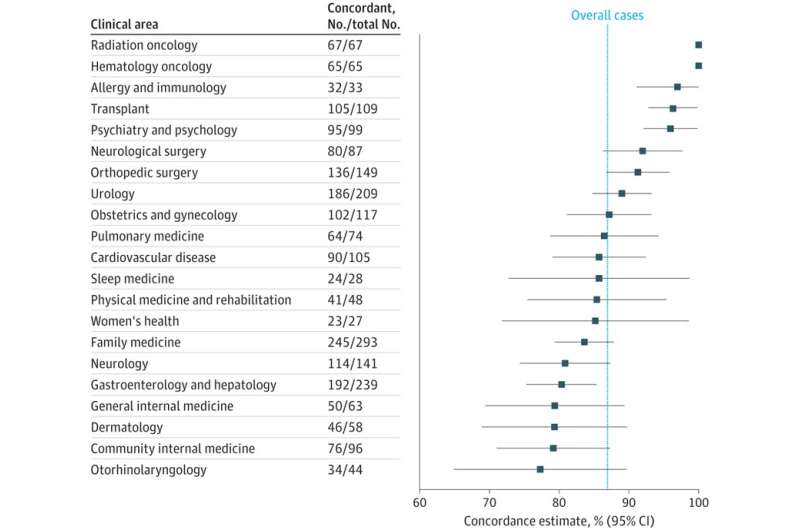Studies into video telemedicine diagnostic accuracy and patient satisfaction find positive trends

During the first months of the COVID-19 pandemic, clinicians across Mayo Clinic transitioned to virtual modes of care to continue to treat patients safely—resulting in an increase of over 10,000% in video telemedicine visits between patients and clinical care team members across the organization. These monumental shifts in care delivery also made for an opportunity to conduct some of the largest video telemedicine studies to date.
"The increased utilization of video telemedicine allowed us to evaluate a variety of patient populations and care needs that had historically been challenging to capture due to slow growing adoption," says Bart Demaerschalk, M.D., who helped to lead the studies from Mayo Clinic's Center for Digital Health. "Nearly overnight, departments and specialties that had historically relied on in-person care had to transition to telemedicine, vastly expanding the possibilities for research."
Their findings have resulted in two studies so far, one published in JAMA Open Network and the other in the Patient Experience Journal. The results signal positive trends in patient satisfaction with telemedicine and also highlight the diagnostic accuracy of these virtual encounters as it relates to in-person care.
Telemedicine diagnoses match those of in-person appointments most of the time
In one study published in JAMA Open Network, researchers found that 87% of the preliminary diagnoses made during telemedicine appointments were later confirmed during in-person appointments.
To put it simply: diagnoses over video are usually spot on.
Researchers evaluated more than 97,000 video visits across Mayo Clinic between March and June 2020. Of those visits, 2,400 patients had a visit for a new health concern and followed up with an in-person appointment within 90 days.
The highest rate of matching telemedicine and in-person diagnoses was found in specialties that included psychiatry and psychology, allergy and immunology, orthopedics, and urology. While diagnostic concordance was slightly lower in specialties such as dermatology and ear, nose and throat (ENT), still, close to 80% of those diagnoses were confirmed in person.
Dr. Demaerschalk says these findings highlight the importance of a hybrid care model and should be reassuring to patients and providers.
"When it comes to care delivery, there is no one-size-fits-all solution," says Dr. Demaerschalk. "Some conditions, like mental health diagnoses, depend heavily on conversations to inform diagnoses, which bodes well for a video visit. Other conditions may be tough to pinpoint without a physician exam, imaging or tests. In these instances, video visits may better serve as an entry point to in-person care."
Patient satisfaction scores align across video telemedicine and in-person visits
In another study published in the Patient Experience Journal earlier this month, researchers within Mayo Clinic's Center for Digital Health and the Office of Patient Experience evaluated patient satisfaction scores from over 300,000 patients treated either in person or via video telemedicine during the COVID-19 pandemic.
Their findings marked a positive shift for telemedicine. Patient satisfaction ratings were overall equivalent across in-person visits and video telemedicine. The team also observed several interesting trends with certain age groups, genders and races, which countered historical perceptions of telemedicine and represent opportunities for future study.
"We found the highest level of patient satisfaction with telemedicine visits was among patients within the 65-year-old to 79-year-old age range," says Nicky Ploog, digital practice enablement manager for Mayo Clinic's Center for Digital Health and first author on the study. "Historically, there has been the belief that this age group is resistance to telemedicine, but these findings highlight how important it is we target telemedicine to all patients, not just the younger, perhaps more tech-savvy users."
However, some of the researchers' findings did align with historical findings for telemedicine satisfaction. For example, patients reported significantly higher satisfaction with in-person visits for specialty appointments. These findings are consistent with prior observations, which have found that patients with complex and serious clinical needs report greater satisfaction when they are able to spend more time engaging with staff and care teams, such as during an extended in-person visit.
Conversely, researchers saw significantly higher satisfaction with video telemedicine for presurgical and postsurgical interventions, driven largely by differences in satisfaction among orthopedic and general surgery.
"The differences we observed may be due to a number of things: patient expectations, how far away they are located from Mayo Clinic, and more," says Laurie Wilshusen, Mayo Clinic's director of Patient Experience Research and an author on the study.
"What is most important to note is that satisfaction was consistently high across both video telemedicine and in-person care, showing that as telemedicine visits become more common, we can bring the Mayo Model of Care to all patients, regardless of if that's in-person or virtually," says Wilshusen. The researchers hope their findings provide objective insights into patients' views on different care models, allowing for health care systems to more broadly consider how video telemedicine services may be employed for the benefit of both patients and staff.
More information: Bart M. Demaerschalk et al, Assessment of Clinician Diagnostic Concordance With Video Telemedicine in the Integrated Multispecialty Practice at Mayo Clinic During the Beginning of COVID-19 Pandemic From March to June 2020, JAMA Network Open (2022). DOI: 10.1001/jamanetworkopen.2022.29958
Nicole J Ploog et al, Outpatient visit modality and parallel patient satisfaction: A multi-site cohort analysis of telemedicine and in-person visits during the COVID-19 pandemic, Patient Experience Journal (2022). DOI: 10.35680/2372-0247.1704



















